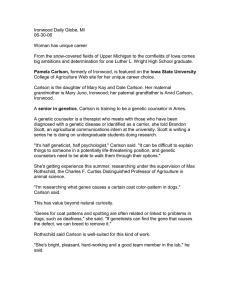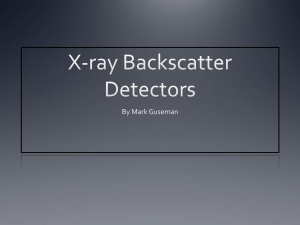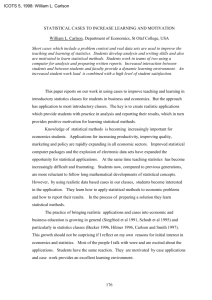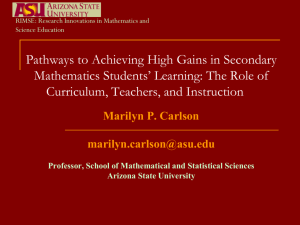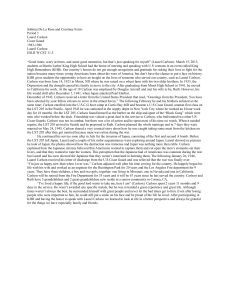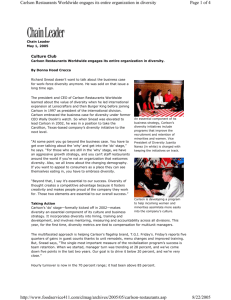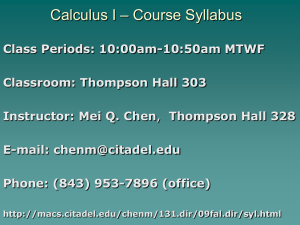Covariational Reasoning Literature Review
advertisement
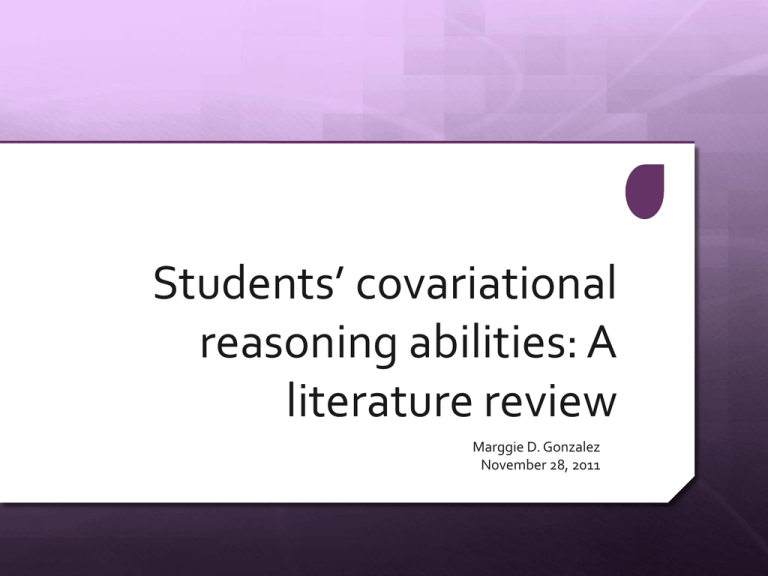
Students’ covariational reasoning abilities: A literature review Marggie D. Gonzalez November 28, 2011 Importance of the Topic Function is an important and unifying concept in modern mathematics, central to many different branches of mathematics, and essential to related areas of the sciences (Carlson, 1998). It is well documented that high performing pre-calculus and calculus students have weak understandings of the function concept and difficulty modeling function relationships involving the rate of change of one variable as it continuously varies with another variable (Carlson, 1998; Monk & Nemirovsky, 1994; Oehrtman, Carlson, & Thompson, 2008; Thompson, 1994). This ability to reason covariationally has been shown to be critical in the understanding of functions, central concepts of calculus (Carlson, 1998; Carlson, Jacobs, Coe, Larsen, & Hsu, 2002; Thompson, 1994). Importance of the Topic As future educators of students that are looking into taking calculus in their near future, it is imperative for them to have a strong conceptual understanding in the areas of functions and rate of change. Little research has been done to describe prospective secondary mathematics teachers’ abilities to reason in dynamic situations. NCTM (2000) Algebra Standard for Grades 9-12 analyze functions of one variable by investigating rates of change, intercepts, zeros, asymptotes, and local and global behavior “In high school, students should analyze situations in which quantities change in much more complex ways and in which the relationships between quantities and their rates of change are more subtle… Working problems of this type builds on the understandings of change developed in the middle grades and lays groundwork for the study of calculus” Example: The given graph represents velocity vs. time for two cars. Assume the cars starts from the same position and are traveling in the same direction. Carlson (1998) Common Core Standards Grade 8 - “Students grasp the concept of a function as a rule that assigns to each input exactly one output” (CCSSI, 2010, p. 52). High School – “Because functions describe relationships between quantities, they are frequently used in modeling (CCSSI, 2010, p. 67). “For a function that models a relationship between two quantities, interpret key features of graphs and tables in terms of the quantities, and sketch graphs showing key features given a verbal description of the relationship” (CCSSI, 2010, p. 69) Functions: According to the literature, functions can be seen as static or dynamic: Static Dynamic Point-Wise Across-Time Correspondence Approach Covariational Approach Action View Process View A dynamic conceptualization of functions is essential to be able to coordinate changes in two variables simultaneously (Confrey & Smith, 2005; Monk, 1994; Oehrtman, Carslon & Thompson, 2008) Covariational Reasoning Carlson (1998) Participants: college algebra (n=30), second semester calculus (n=16), and beginning graduate study in mathematics (n=14) Data collection: pre-test and clinical interviews (n=15) From results a Covariational Framework was developed. What is covariational reasoning? Are the "cognitive activities involved in coordinating two varying quantities while attending to the ways in which they change in relation to each other" (Carlson et al, 2002) Change refer to both: how things change and at what rate. Direction of change (increasing, decreasing) Amount of change (average, instantaneous) Task: Imagine this bottle filling with water. Sketch a graph of the height as a function of the amount of water that’s in the bottle. The Bottle Problem: Carlson (1998) Carlson, Jacobs, Coe, Larsen, and Hsu (2002) Covariational Framework Mental action Description of mental action Behavior Mental Action 1 (MA1) Coordinating the value of one variable with changes in the other. Labeling the axes with verbal indications of coordinating the two variables (e.g., y changes with changes in x). Mental Action 2 (MA2) Coordinating the direction of change of one variable with changes in the other variable. Constructing an increasing straight line Verbalizing an awareness of the direction of change of the output while considering changes in the input Mental Action 3 (MA3) Coordinating the amount of change of one variable with changes in the other variable. Plotting points/constructing secant lines Verbalizing an awareness of the amount of change of the output while considering changes in the input Mental Action 4 (MA4) Coordinating the average rate-of-change of the function with uniform increments of change in the input variable. Constructing contiguous secant lines for the domain Verbalizing an awareness of the rate of change of the output (with respect to the input) while considering uniform increments of the input Mental Action 5 (MA5) Coordinating the instantaneous rate of change of the function with continuous changes in the independent variable for the entire domain of the function. Constructing a smooth curve with clear indications of concavity changes Verbalizing an awareness of the instantaneous changes in the rate of change for the entire domain of the function (direction of concavities and inflection points are correct) Carlson, Jacobs, Coe, Larsen, and Hsu (2002) The Car Problem: A car is traveling down the road between cities A and B. Sketch a graph of his journey where his distance from A is noted on the horizontal axis and his distance from B on the vertical axis. Examples from students: Future Research! What needs to be done in middle/high school so that students in college level enter calculus with a stronger understanding of the function concept? We need more studies done with middle/high school students (Only 5 studies focused on out of 21) What about prospective secondary mathematics teachers? From 16 studies done with undergraduate students, only 4 were focused on prospective teachers. Future Research! Need to be able to measure growth in students covariational reasoning abilities. Kevin Moore, Marilyn Carlson and Michael Oehrtman, from ASU, designed a course ”informed by theory on the process of covariational reasoning and selected literature about mathematical discourse and problem-solving” (Moore, Carlson, and Oehrtman, 2009, p. 7). Most of the research that has been done has reported results based on clinical interviews. What about the use of a pre and a post instrument? Future Research What about the creation of a common instrument? Is that possible?? Use of the same tasks so that qualitative results are parallel. Use of a quantitative instrument to be use as a pre-test and as a post-test that is common among researchers trying to understand students covariational reasoning abilities. Questions? Function as a static situation Point-wise (Monk, 1994) Students tend to calculate value of a function for every input values by making precise measurements Correspondence Approach (Confrey & Smith, 2005) “one initially builds a rule that allows one to determine a unique y-value from any given x-value… build correspondence between x and y” (p. 33) Action view (Dubinsky & Harel, 1992; Oehrtman, Carslon & Thompson, 2008) Involve the ability to plug numbers into an algebraic expression and calculate. Subject tend to think about it one step at a time. Able to form the composition of two functions defined by algebraic expressions, but not when the two functions are defined by tables or graphs. Function as a dynamic event Across-time (Monk, 1994) “How does change in one variable lead to change in others? How is the behavior of the output variable influenced by variation in the input variable?” (p. 21) Covariational Approach (Confrey & Smith, 2005) “Entails being able to move operationally from ym to ym+1 coordinating with movement from xm to xm+1“ (p. 33). Process view (Dubinsky & Harel, 1992; Oehrtman, Carslon & Thompson, 2008) “it requires one to be able to disregard specific computations and to be able to imagine running through several input-output pairs simultaneously” (p. 5).
